#roman army museum
Explore tagged Tumblr posts
Text
Roman Army Museum
The Roman Army Museum was our last stop on the tour of the Roman Wall, which Emperor Hadrian built across England. But first, a few more photos of the Northumbria countryside.



It's quite pretty, rolling hills, pastures filled with sheep and woodlands.
Back to the Roman soldiers.
Two major categories of Roman Soldiers were the Legion and the Auxiliaries. The Legions were made up of Roman citizens and got more pay, better armor and equipment. The Auxiliaries were men from conquered areas who were not citizens. If they served for 25 years they got Roman citizenship for themselves, one wife, and their children. It seems that they had about a 50% chance of getting there. They were not allowed to marry while in service, but many had informal, long-term relationships.
Hadrian's Wall was built by Legions but staffed by auxiliaries. Here is a Legionare

And here is an auxiliary.

There were also cavalry units.

(I was a little surprised that the cavalry soldier was pictured riding away from the enemy and getting shot in the back!)
Soldiers generally walked and carried all their gear. They didn't have large baggage trains, so they were wearing their armor, helmet, and sword, carrying their shield, two lances, camping gear, cooking pot, canteen shovel, pick axe, and more—over 80 pounds worth. They typically marched over 20 miles a day and then dug a fortification trench around their campsite with wooden pikes.




They must have made quite a racket when marching.
It was an impressive, fit, and hard-working army; little wonder they were so successful.
0 notes
Text

Antoninus Pius (AD 138-161)
ANTONINVS AVG PIVS PP TRP COS III The Emperor Antoninus Pius, Father of his Country with Tribunician Power, Consul for the third time.
Antoninus was adopted by the Emperor Hadrian. Despite a lack of experience in government, he proved to be an efficient and respected emperor. The extension of the frontier into Scotland gave Antoninus valuable military prestige and gained him an Imperial Acclamation, commemorated on a coin with the words IMPERATOR II.
Hunterian Museum, Glasgow
#romans#roman empire#roman emperor#roman army#roman coins#archaeology#symbols#roman soldiers#ancient cultures#ancient living#metalwork#coins#hunterian museum#Glasgow
104 notes
·
View notes
Text





Jousting Armour and Horse from the Holy Roman Empire dated to the 16th Century on display at the Museum of the Army in Toledo, Spain
This set of armour is made up of original 16th century parts and recreated 19th century segments. The replicas are engraved in the same style as the originals to make them look the same.
Photographs taken by myself 2019
#military history#art#armour#cavalry#holy roman empire#spain#spanish#16th century#renaissance#museum of the army#toledo#barbucomedie
80 notes
·
View notes
Text
youtube
I thought that Legion: Life in the Roman Army was… fine? While there were parts that I very much enjoyed, it had several glaring issues concerning accessibility, crowds, and dramatic shifts in tone.
There was also a rat.
55 notes
·
View notes
Text
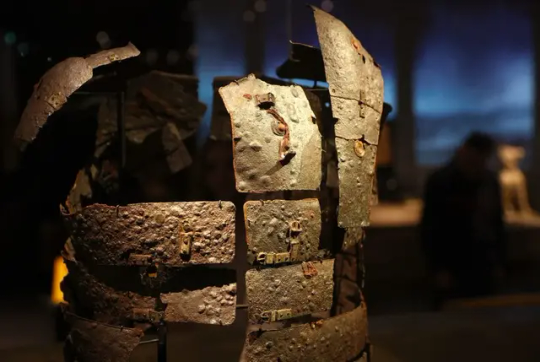
What Was Life Like in the Roman Army?
The British Museum’s New Show Offers a Peek
"Legion" showcases objects including scabbards, coins, and the world's only intact legionary shield.
The viral nature of the term “Roman Empire” makes it easy to forget the trend started because ancient Rome had one of the most unforgettable armies in history. A new show at the British Museum is turning the spotlight on the soldiers that helped build and safeguard Roman rule.
Legion: Life in the Roman Army” transports visitors to the million square miles that was once the Roman Empire to explore its unparalleled military might through the eyes of the people who lived it. The museum already has a dedicated gallery space covering the rise of Rome from a small town to an imperial capital, covering a period of about 1,000 years. But the latest show humanizes that collective power through more than 200 exhibits ranging from soldierly objects to everyday items that capture the lives of citizens living under military rule.
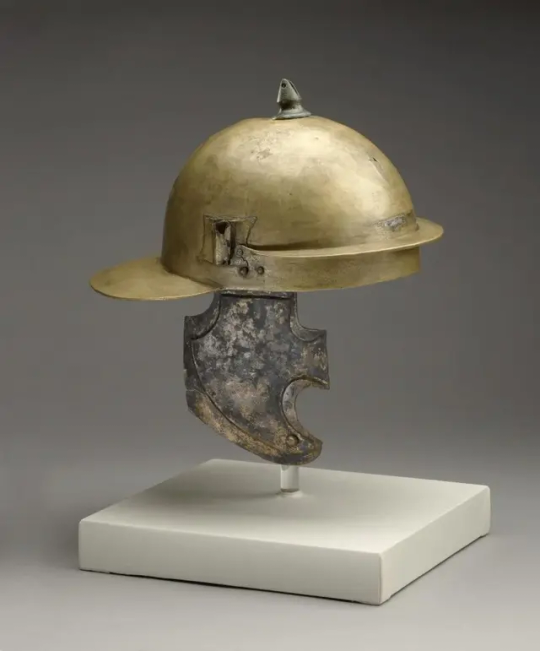
Copper alloy Roman legionary helmet.
“Few men are born brave,” wrote Vegetius in the later Roman Empire. “Many become so from care and force of discipline.” From the 6th century B.C.E., soldiering was a career choice and joining the army came with substantial perks (if you lived), including a substantial pension. Foreigners entering the auxiliary troops could also attain citizenship for themselves and their families.
The show traces the journey of a notable Roman soldier, Claudis Terentianus, following him from his enlistment to his participation in campaigns to his retirement. Along the way, visitors can view the armor and weapons soldiers wielded in battle, from a gilded bronze scabbard to a copper alloy helmet to the world’s only intact legionary shield. Domestic objects such as children’s shoes illustrate the family life of military men; coins and tombstones allude to the cost of the empire’s wars.
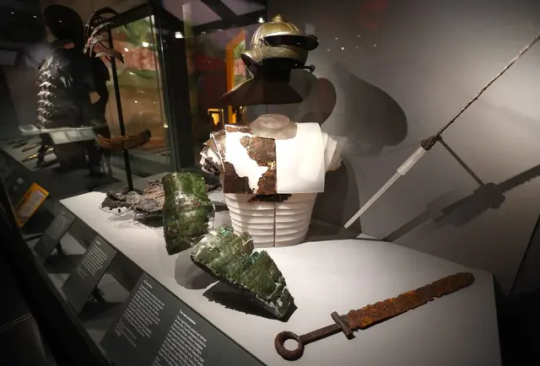
Also included in the show is an ancient Roman arm guard, found in fragments in 1906 and recently reconstructed by the National Museums Scotland—the first time the artifact can be viewed in its entirety in millennia.
“Sword and sandals, helmet and shield are all on parade here as would be expected, but told through often ordinary individuals,” Richard Abdy, the museum’s curator of Roman and Iron Age coins, said in a statement. “Every soldier has a story: it’s incredible that these tales are nearly 2,000 years old.”
By Jamie Valentino.

A helmet depicting the face of a Trojan.
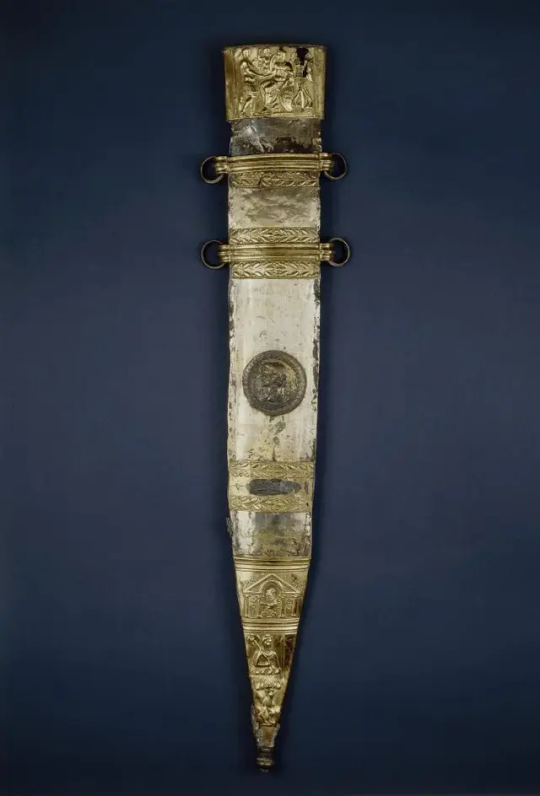
Sword of Tiberius – Iron sword with gilded bronze scabbard.

Tombstone of an imaginifer’s daughter, 100-300 C.E.
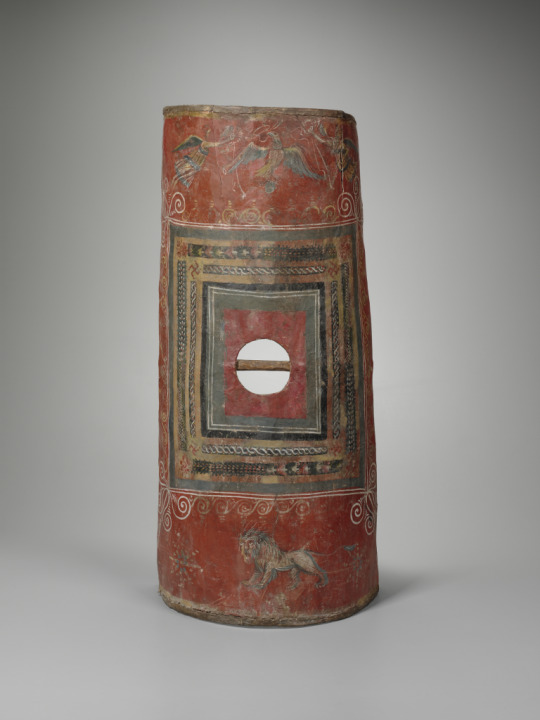
Roman scutum (shield).
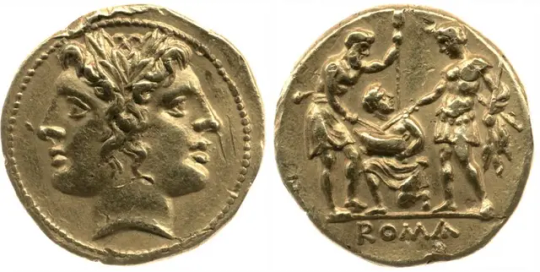
Gold coin featuring an oath-taking scene between two soldiers.
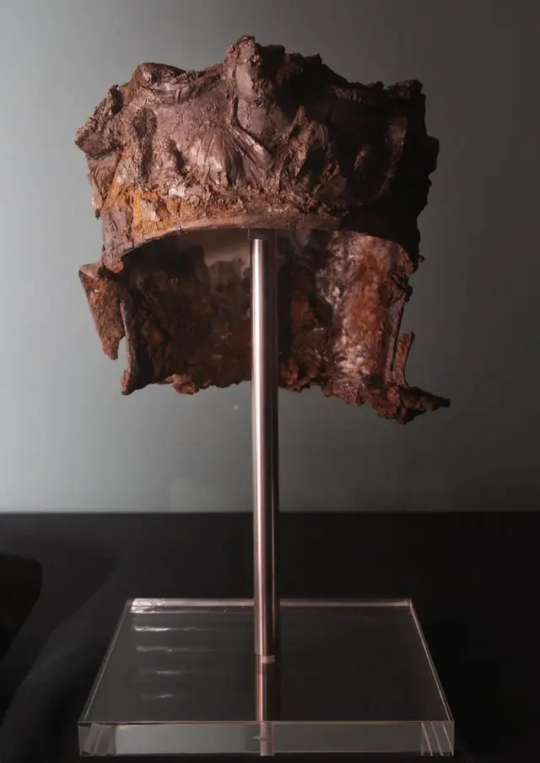
A 2,000-year-old Roman cavalry helmet.

#What Was Life Like in the Roman Army?#The British Museum#Legion: Life in the Roman Army#Claudis Terentianus#ancient artifacts#archeology#archeolgst#history#history news#ancient history#ancient culture#ancient civilizations#roman history#roman empire#roman legion#roman art#ancient art
22 notes
·
View notes
Text
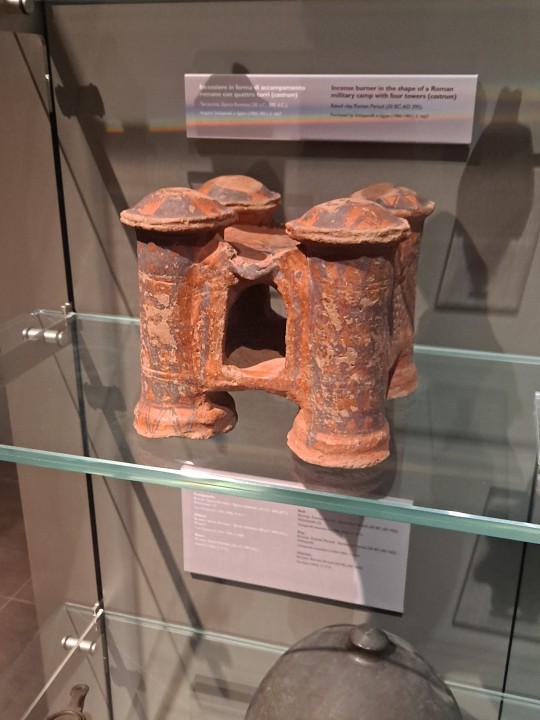
Insence burner in the shape of a Roman military camp
* Roman Egypt
* 30 BCE -395 CE
* Egyptian Museum, Turin
Turin, June 2023
115 notes
·
View notes
Text
Here there be dragons:

4 notes
·
View notes
Text
25th February 2024 British Museum: Legion: life in the Roman army Part 8
Nearly there now!
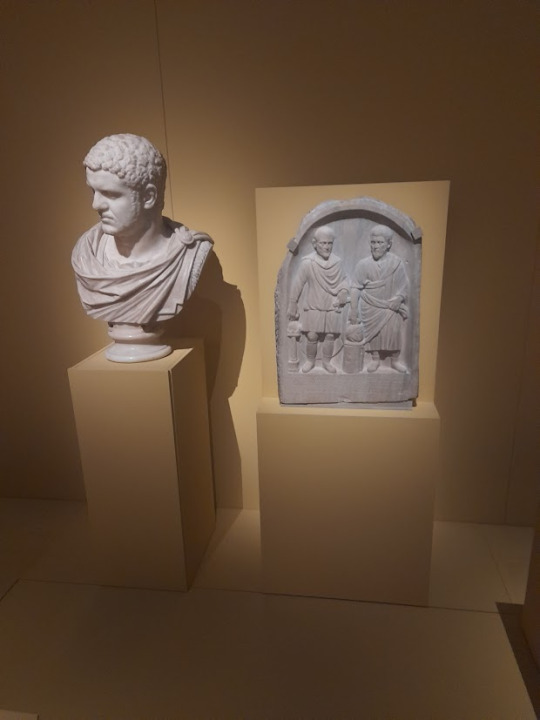
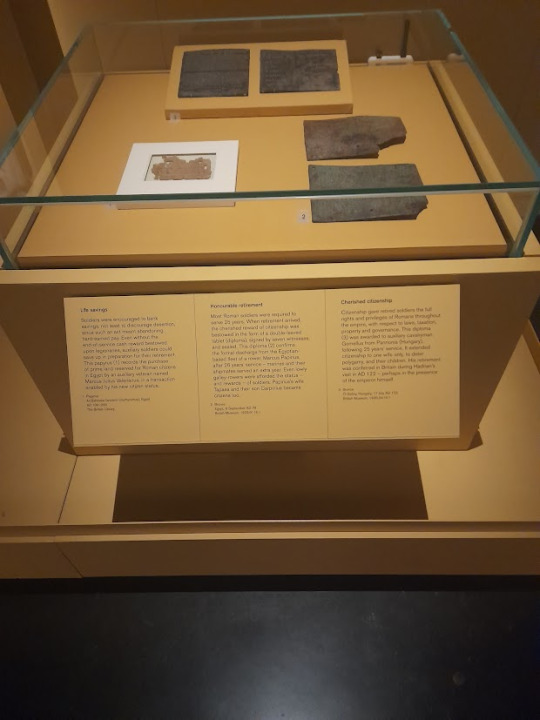
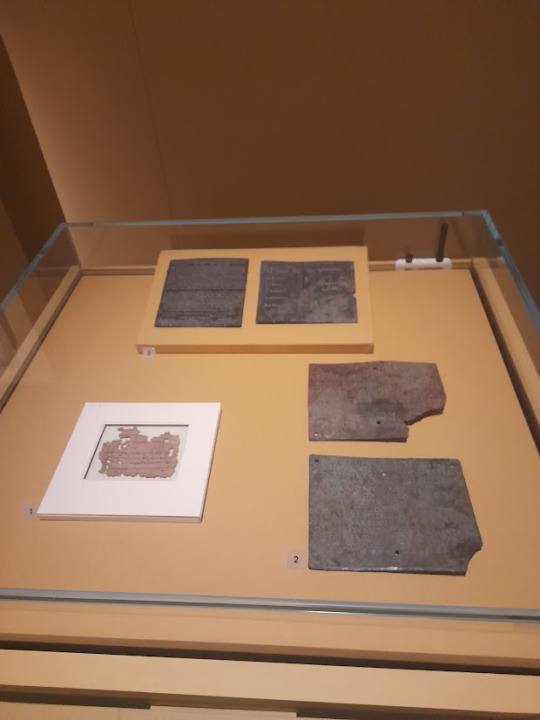

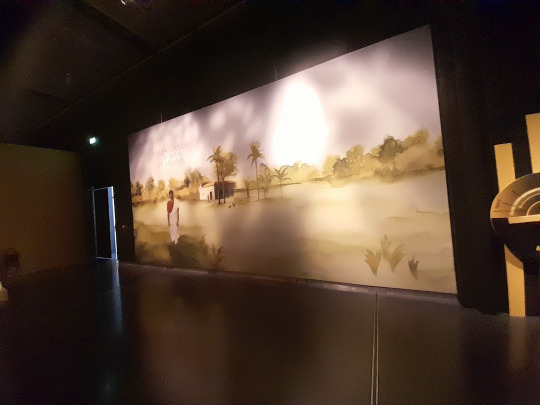
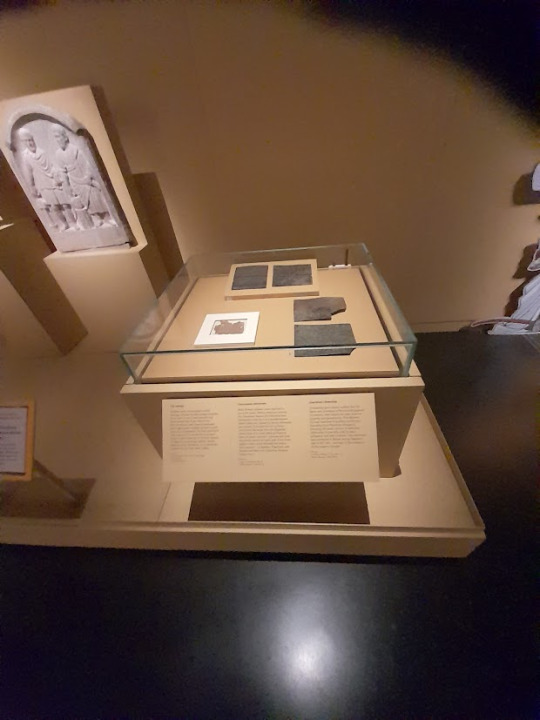
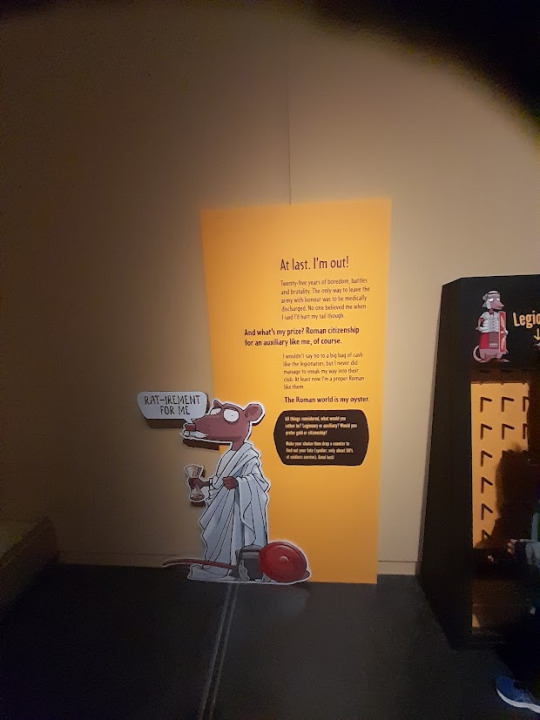
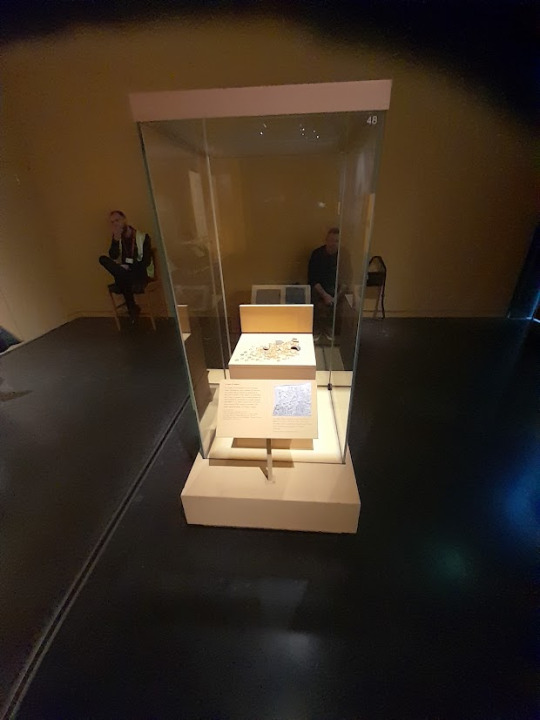
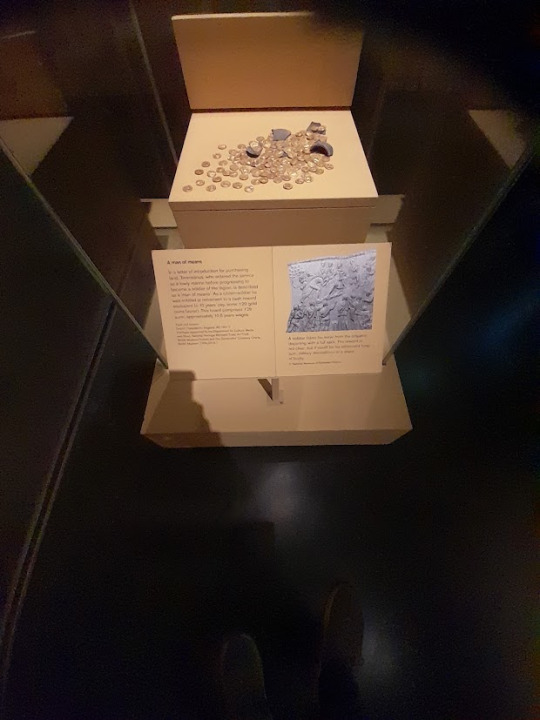
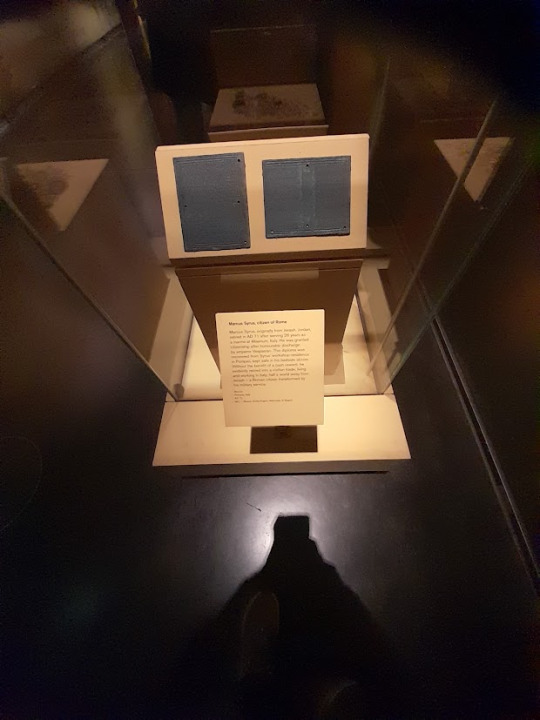

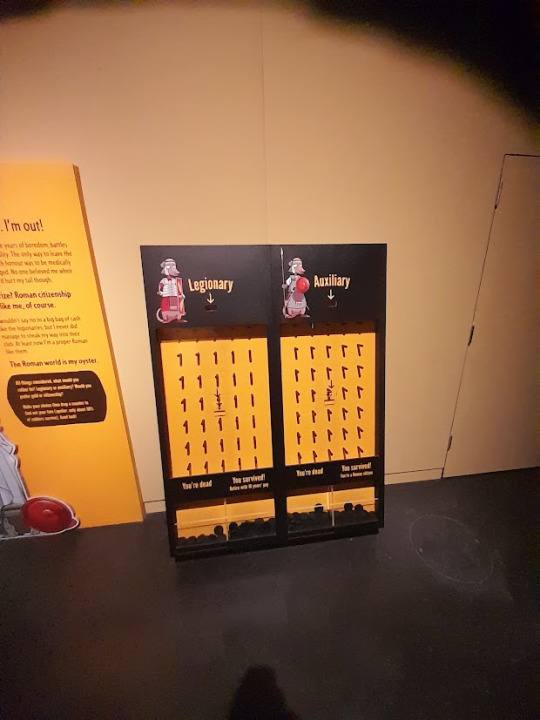
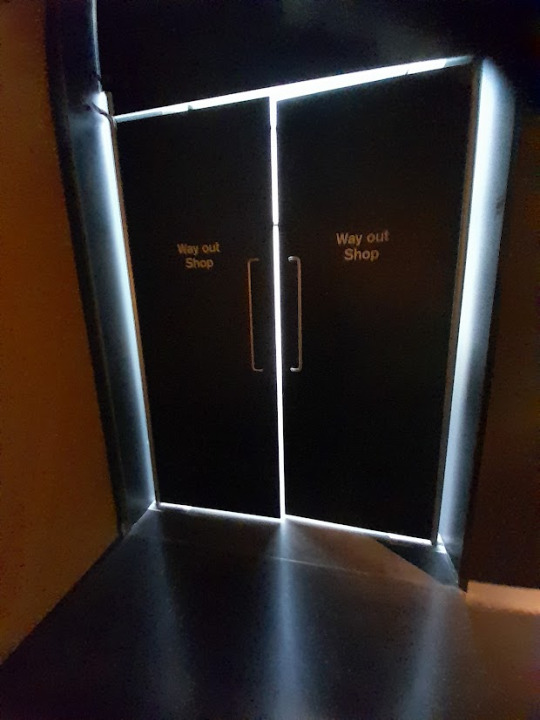
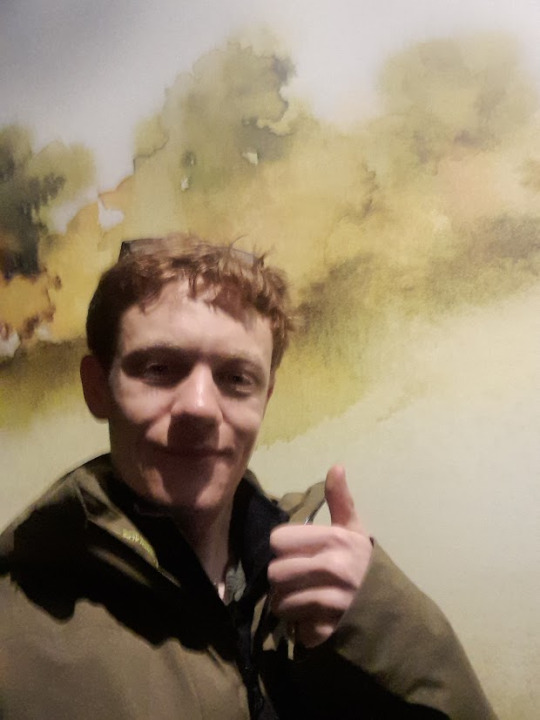
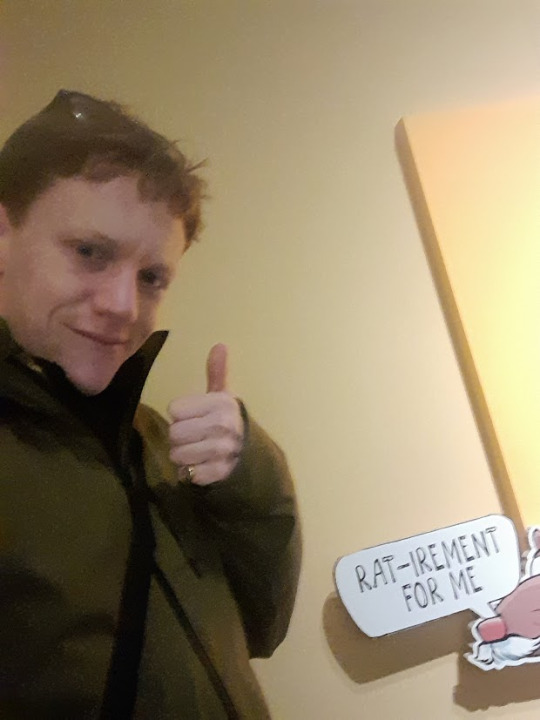
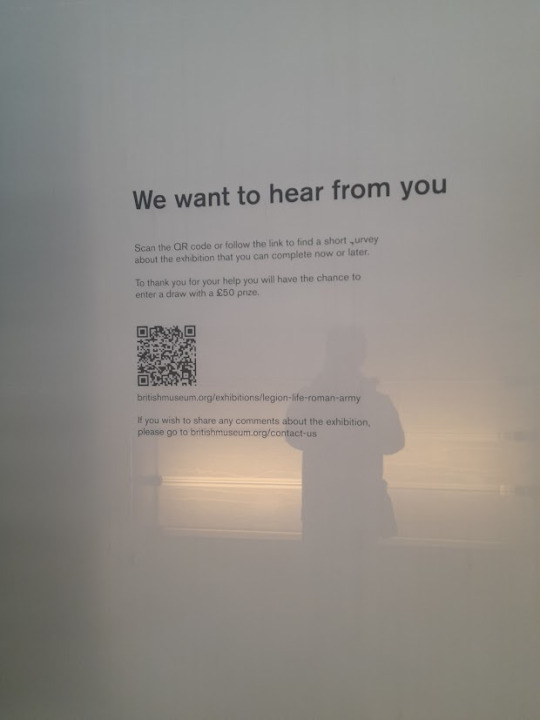
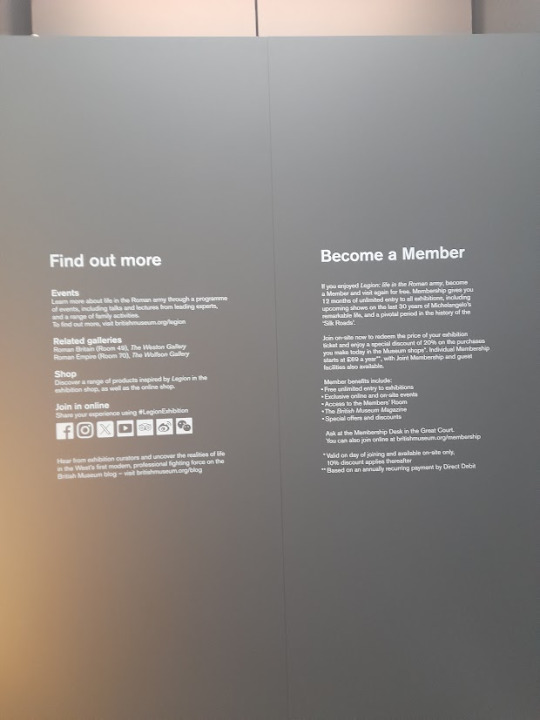
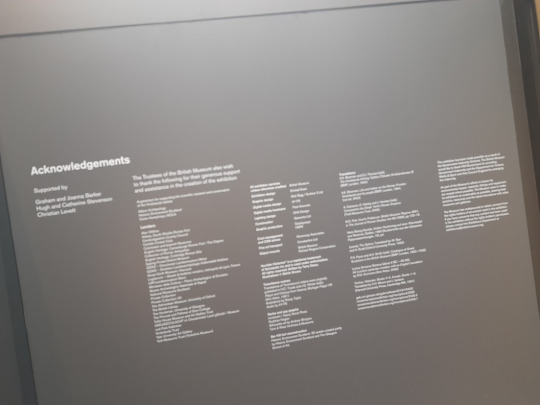
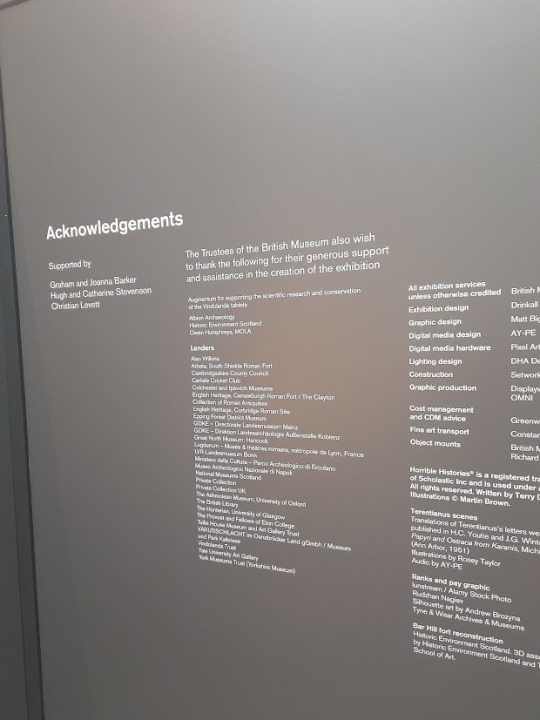




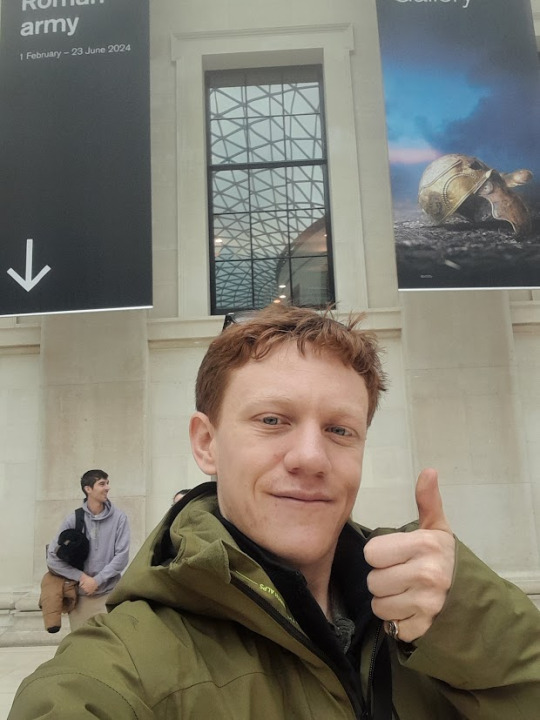
That's it!
0 notes
Text
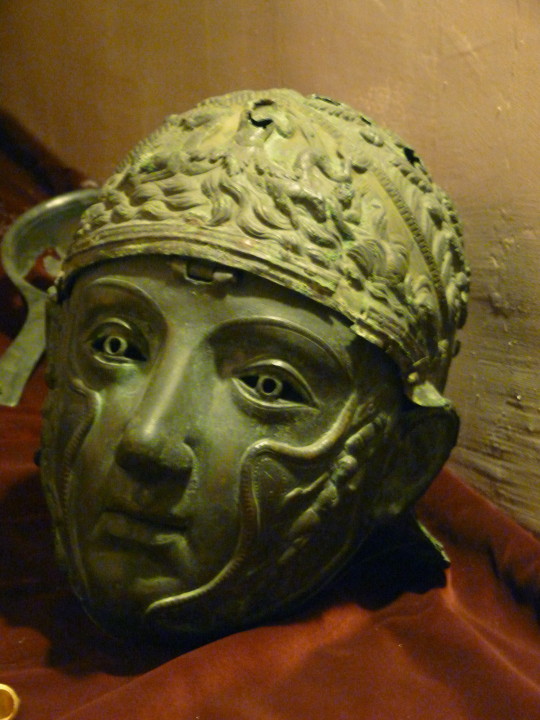
Today's Flickr photo with the most hits: this 1st CE Roman parade helmet, housed in Istanbul's archaeological museum, and excavated from the Vize tumulus.
0 notes
Text

Marble statue -100–200 AD- of a Molossian dog, an extinct breed. Roman writer Ovid mentioned Molossian dogs in his work. These dogs worked in the Roman army, as guards to add security to the fort. They were also good company and guardians in the richest houses.
British Museum
530 notes
·
View notes
Text

I also saw the Vindolanda Mouse, of course


Very important pictures from the Vindolanda Museum (it’s been raining today so, no excavating but museum wandering).
#they just dropped a phallus pin#commissioned just for them#a shipment just arrived to the Vindolanda Museum#idk if the Roman Army Museum got them too#but if you are in the area you should definitely come see Vindolanda#if you show up during the week you’ll get to see the next team of volounteer dig and might get to have a chat with Andrew or Marta#they are fantastic and very willing to share some information
51 notes
·
View notes
Text
cosmic love
Marcus Acacius x F!Reader x Marcus Pike

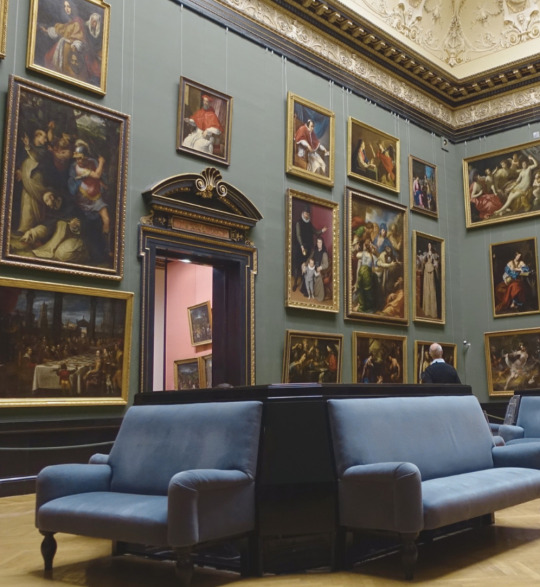
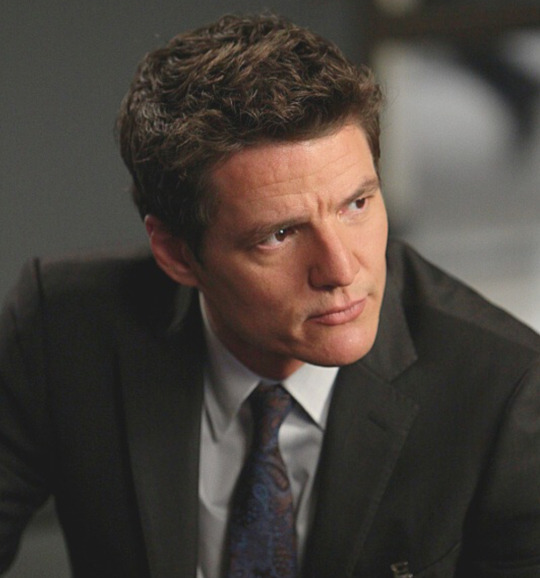
summary: a missing statue, a handsome ancient roman general, an equally handsome museum visitor - and you caught in the magical (and wonderful) mess of it all
tags & warnings: 18+ ONLY MDNI, MAJOR GLADIATOR 2 SPOILERS. time travel AU, magic elements, pining & yearning, fluff but with touches of angst, implied age gap (Acacius being older than both reader & Marcus), light use of gendered language, bi!Marcus Acacius & bi!Marcus Pike, brief mention of death & existential questioning, spicy themes, smut (threesome, m!oral, one moment of spitting) M/M/F & M/M dynamics, polyamorous exploration that leads to eventual poly relationship, no use of y/n
word count: 7.5k
a/n: I’m sorry I blame the gladiator statue pics we got & yeah now here we are lmao, this fic literally wouldn’t be here without @pedgito & @perotovar - i can’t thank you two enough for all the help i love y’all tremendously, also a sweet special tag for @morallyinept ily too… And lastly - thank you for reading, you’re what makes this so special and magical ♡

The statue that arrived with the newly updated Roman exhibition at your museum has gained attention.
As a guide you enjoy seeing all the new faces here to check out the freshly opened installation. The heightened foot traffic has kept you and your co-workers busy, but it’s been a nice welcome.
Your eyes drift to the statue now.
General Marcus Acacius stands slightly weathered yet still commanding in his bronze glory, towering among the room with all the grace a powerful Roman Army commander would be.
You learned he conquered countless territories and countries in the name of the Ancient Roman Empire. Eventually though, he was caught in a conspiracy to overthrow the ruling emperors and died within the eyes of the coliseum, the whisper of a gladiator’s death.
Now you readily explain this all to tour groups like the one you currently guide.
“Oh, he’s cute.” One of the elementary school girls currently giggles to her friend. The other school children gasp around her, teasing her.
“It’s okay. He is pretty handsome, isn’t he?” You reassure her. The girl seems bashful but relieved at your agreement.
It wasn’t just you. A local internet influencer stopped by and even made a video about the statue being her dream guy.
Even as a statue, the General is eye-catching.
The bronze figure captured his likeness bewitchingly detailing the soft curls of his hair, a lovely sharp nose, mountainous strong broad shoulders, and a pensive stare looking out to a distant horizon. He’s a man of unwavering beauty.
You constantly want to smack yourself for being wistful over a piece of art.
“He’s definitely the most attractive statue I’ve seen.” A familiar smooth sweet voice melts into the room’s quiet softness making your heart jump.
Approaching you with a molten smile and eyes twinkling in the low museum lights, Marcus doesn’t seem real at times.
A regular visitor, you first met him when he accidentally crashed one of your tours. Wholesomely thoughtful, but also being a charming yet slightly know it all, he was quick to join in on commentary of the paintings. With his Disney prince-like smile and earnest eager energy, you couldn’t dare shoo him away.
Now you happily seek his company.
“He’s become like a hot new celebrity here.” Joking, you nudge towards the General’s striking figure.
“I can see why.” Marcus whistles low. “Like look at those shoulders.”
You snicker as a bubbling fondness swells in you.
“He unfortunately died a tragic death.” Marcus comments, cloudy and mournful.
“Yeah, I heard. That means this guy is a bad boy.” You nod.
Marcus snickers at your comment then playfully nudges you with his elbow.
Later, all your co-workers beg you to ask him out to coffee.
“He’s totally got the hots for you!” Your favorite co worker often tells you, but you wave her off.
Marcus is just sweet. He’s kind and considerate, engaging to all the workers here. Besides, you don’t want to assume he possibly likes you and maybe ruin the precious friendship you have with him.
However, your favorite coworker shows up a few days later with a solution for your stale love life.
With a cheeky bright grin, she hands you the cutest pink velvet pouch in the break room.
“It’s called a love wish tea.” She declares.
She grabbed a pack of them at the local occult shop after the lovely witch who owned the place swore it worked.
“It calls in your heart’s desires and hey, it worked for me! That’s why I still have a pack left over!” She proudly recommends.
You roll your eyes but appreciate the gift.
Shoving it into your bag, you don’t give it much thought.
Then the cooler cozier weather settles in, the perfect time for museum dates. Strolling along the floors keeping a watch on everyone it’s hard not to notice the intake of couples. Some are intertwined beside each other staring fondly at a painting together, while others happily take photos of the other being silly.
A taste of loneliness fills you, but gently you sweep it away focusing back on work. Especially since tonight you’ll be locking up.
Already craving some extra caffeine, you glare seeing the break room depleted of any sweet salvation.
The small velvet pink bag in your bag immediately comes to mind. And at this point you think, why not. it will at least keep you awake.
Immediately out of the pouch the tea bag releases a soothing smell, a rich floral blending with delicate touches of a fruit scent, possibly pomegranate. You’re now excited just to taste it, love wish or not.
The tea steeps in your tumbler cup allowing a faint rose color to float into your water. Of course the tea is pretty too.
And the taste? Rich, lovely and warm, like a romantic valentine-like themed drink. It doesn’t reward you with a sensation of being in love, but instead you feel at peace.
After a few sips, you return to the floor.
There, Marcus sits on one of the benches in the Roman exhibition.
Curled over a leather sketchbook, he’s every bit the personification of a scholarly beautiful artist straight out of a romance novel. His face glanced up then back down to his sketch. Diligent concentration paints over his gorgeous face.
Cautious, yet eager, you approach.
He’s sketching a portrait of the General. The sharp edges of the charcoal, the smudges meant to mimic shadows, along with capturing the striking slopes of the General’s features - it’s fantastic.
“You’re amazing!”
Your compliment causes him to jolt slightly spooked, and you rapidly apologize. Once he catches sight of you, Marcus sighs with a dreamy relieved sleepy grin.
“Just sketching, nothing too crazy.”
You take a seat besides him on the bench.
“You captured his likeness so well already.” You’re in awe at the sketch.
Marcus laughs a bit nervously. It’s hard trying not to swoon at the light rose blush coloring his cheeks. He’s stunning.
“I bet General Acacius would be flattered.” You grin then glance back to the statue.
Marcus turns to follow your sight.
“Nah, he strikes me as a big relief fan.” Marcus comments thoughtfully.
The bad art joke isn’t lost on you, and you snicker beside him. Among the giggles you catch Marcus staring at you, the softest boyish grin tugging his lips.
The world melts into a splendid focus all on him.
This isn’t good. You can’t be thinking about possibly leaning in to kiss cute visitors while you’re still on the clock.
“Hey… so I’ve been meaning to ask if maybe we could-”
His phone ringing cuts Marcus off causing you to shoot up from the bench. Jumping on the call, Marcus seems apologetic and almost sad as you wave him bye to him.
Closing time approaches. You and your co-workers do one final look around the rooms. Marcus is nowhere to be found.
The Roman exhibition now sits sleepily still.
The dim glow coats the general’s statue, a glistening chopper. Even with the chips and weathering of time, he stands glorious as you stroll closer.
He really must have been something fierce for the empire to immortalize him in such grand fashion.
“You must’ve been a pretty amazing man.” You mutter mainly to yourself, gently touching the base of the elevated display platform he rests upon.
You wish him a good night and head home. You try not to think of stunning statues or cute museum visitors.
Next morning you’re woken up by a call from work, a frantic one.
“The fucking hot ass statue is missing.” Your co-worker hisses.
You don’t believe it till you see it.
But you’re knocked breathless at the sight.
General Marcus Acacius is missing. The once grand presence he added to the room is absent, vanished, as if plucked from the air itself.
It’s almost unnerving to see the once elevated space now hauntingly vacant.
Chaos brews humming all around. Copes scurry around everywhere, and plenty of people stand outside curious to what’s going on. A controlled whirlwind fills your museum. Various officers keep the scene roped off.
The museum decides to close for the rest of the week to let the police handle as much as they can. You adore the museum truly, but there’s one spot you love the most. Right by the break room leading from various different doors is an outdoor courtyard. It’s become a place of solace.
The bubbling dread has you stepping out here one more time. The sky above looms with a cold front approaching and casts a somber shadow over the space even more.
The shrubs rustle off the side among the thick greenery, and you figure it’s a bird.
“It’s you.” Until a new voice speaks to you. Rich, heavily accented and smooth, it startles you.
You wonder if you’re imagining things.
The man is dressed in Roman attire, elaborate white armor adorned with ornate gold pieces. Glorious graying curls frame his ethereal aged face.
How did a cosplayer manage to sneak in?
He stares so directly at you it frightens you a bit.
“You’re the one who’s voice I heard…” he continues to speak. “It was like I was asleep, drifting away. Then you woke me.”
“Sir, how did you manage to get in here?” You ask, trying to stay as calm as you can.
“I do not know. I simply woke and found myself in this strange place.” He explains with a furrowed brow.
You wonder…is this a strange bit the museum is maybe trying to pull off, and they didn’t tell you.
He steps forward now, and instinctively you walk back cautious. The man must take in your reaction because his face, his handsome face that now looks vaguely familiar, frowns. He holds his hands up defensively.
“I mean no harm. I just need to know what happened to me.”
Someone calls out your name, sounds like your boss. “Come on let’s head out.”
The stranger repeats it and how smooth his voice is, your name rolls off his tongue.
“I am General Marcus Acacius, and I am in need of your assistance.”
That makes your brain scratch.
“Wait, what?” You turn to him confused. “What did you say your name was again?”
He repeats it firmer.
Marcus Acacius.
As in… General Marcus Acacius.
There’s no way.
“Oh, so you’re an actor.” You deadpan.
“I…am confused? I’m no performer. I promise you that.” He almost sounds huffy.
You gotta give him credit. The guy stays in character pretty well.
“You shouldn’t be here, actor or not.” You tell him, heading back inside. Of course this man follows you in.
At the sight of the glass door and the movement of it, he pauses stunned, like he can’t process it. You almost want to laugh.
“You’re pretty good, even though you say you’re not an actor.” You tease.
He frowns hard not enjoying that.
“Either tell me what is going on or I will find a man who will.” He snaps loud and your eyes go wide.
His memorizing face scrunches up in frustration. Dark amber eyes are coated in fierce anger.
“I wake up in a strange place filled with artifacts and see people dressed strange. What is going on?” His voice rises confused, panicking.
Either he’s the most amazing actor ever or…
No.
It can’t be.
Too many thoughts swirl in your head like angry bees trying to make your brain explode.
You need a minute. So you grab the mystery man’s arm, practically dragging him to follow you.
“Excuse you? Where are you taking me?” He demands.
“Somewhere safe.” You half lie.
Unfortunately your boss stops you. His worried eyes catch sight of the man in the armor. You’re quick to explain he’s an actor, upset about the missing statue.
“I am not a-”
You shush the strange man harshly. Your boss, hesitant and worried, surveys him.
“He shouldn’t be here.” Your boss says firm.
“Yup, and I was just showing him the way out.” You happily explain.
Thankfully your boss gets called away, and you make your escape.
“Are you abducting me?” He demands harder.
“Look, I’m the only one here who might be able to help you.” You hiss back.
“I am the commanding General of the Roman armies.” His voice blooms stronger when you reach the lobby. “I will find my way around.”
You swallow hard. A small but chaotic idea quickly jumps into your mind, and you decide to put it into action.
So, you hold the exit door open for him. The man nods to you, then strolls out. You follow him.
The towering skyscrapers, the rush of the cars, the stretching concrete roads, it becomes an overwhelming sight while the man whips his face around eyes wide and in shock. His face falls, aghast and disoriented.
That unrealistic conclusion you thought of - you think it might not be so realistic. Because the man turns to you wearing petrified horror, terrified confusion of a man in an unknown world that no actor could truly capture.
Reality smacks into you like a bag of nails.
This man is truly the great General Marcus Acacius.
The missing statue now full man summoned to life.
Someone yells your name.
Your heart drops. Of course Marcus arrives at the worst time. He jogs up to you dressed in what looks like a gym outfit.
“I heard about the statue.” He says worried then his eyes immediately grow cloudy and confused as he catches sight of the strange Roman dressed man.
“Is he… a friend of yours?” Marcus asks hesitantly.
“It’s complicated.” You blurt, panicked.
General Acacius stands still very stunned trying to take this new modern world in. Stumbling, he returns to your side, clutching your arm like you’re the only one who can steady him.
“I…” Acacius begins then stops mid word, still trying to process a reply. Until he catches sight of Marcus.
“You,” The man surveys Marcus with narrowing eyes. “You seem familiar as well.”
This is getting out of hand.
“Okay time to go.” You rapidly try diffusing the situation, moving General Acacius away from Marcus.
“Wait, what’s going on?” Marcus questions, persistently following behind while you head to the parking lot.
You scramble out a lie that the strange man is an old friend you ran into who just came back from a play.
“I told you, I’m no performer.” Acacius insists still. You also discover he’s built like a wall and trying to wrangle him into the car proves to be Herculean.
Swiftly, Marcus firmly snaps out your name. His tone is different, urgent and enforcing. It turns you into a statue yourself.
Comedically, you’re practically halfway shoving Acacius into the car but now stand frozen. He notices the shift in tension quickly.
“Are you frightened of him?” Acacius mutters concern, surprisingly concerned. “Because I can dispose of this man.”
You shake your head no.
Swallowing hard, you finally look Marcus dead in the eyes.
“If I told you, you wouldn’t believe me.” You admit.
“Try me.” Marcus rebuffs, serious as steel.
So you sigh, what more do you have to lose now?
“General, can you please tell him who you are.” You then allow Acacius to speak for himself.
The ancient Roman clears his throat and announces his full title and name. The younger and modern Marcus’s face twists confused with a hint of concern.
Suddenly his eyes go wide. He catches on fast, figures it out quicker than you did that’s for sure.
This cute casual museum visitor you have a slight crush on is now your accomplice and partner in crime.
At least…now you don't have to deal with an ancient Roman General being brought back to life from stone alone.
— °˖➴ —
Marcus’s apartment is lush and cozy, filled with so many books and records. The warm walls, sleek modern design, make your place feel like a hole in the wall. Having a roommate, you couldn’t just bring home a very confused man out of time. So thankfully Marcus offered his home.
Now you’ve practically been living here with General Acacius trying to figure out what happened.
Acacius takes things rather well, almost in stride. Fitting for a general that explored new territories and had to face the unknown chaos of war.
The fridge fascinates him the most. You had to stop yourself from laughing seeing him open and close the refrigerator door like a child wondering if the food inside would disappear.
Marcus has a vice for candy, specifically sour ones. Seeing General Acacius try one and the disgusted face of twisted torture is a memory you’ve replayed over multiple times.
But unfortunately no one can figure out what brought the statue to life and him here.
“I’m a man. Not a statue.” The roman general clarifies.
“You are now, but we gotta figure out why.” You sigh exhausted while Marcus readies breakfast for everyone.
He’s been an incredible host. It’s been hard not lingering on how domestic and warm he is within his own space.
Especially when there’s also an archaic man looking just as handsome walking around in a tight white t shirt Marcus lent him.
Surrounded by two unbelievably gorgeous men has been a double edged sword, a blessing and curse.
General Acacius reminds you of a mountain, ever powerful, sturdy and unwavering with the change of seasons. Yet there’s still an open vulnerability to him. You’ve seen it in how grateful he’s been and how eagerly he’s tried absorbing all about this new world.
Whereas Marcus reminds you of a river, beautifully flowing, always adaptable. But he surprises you with how direct and firm he’s been, almost protective in keeping you and Acacius safe.
You also don’t miss the way Marcus’s eyes sometimes flicker to sneak a glance at the older General. You can’t blame him.
Acacius fills out modern clothes sinfully. Watching him navigate everything with a certain poised grace is attractive. While Marcus has become endearing and patient, incredibly welcoming to this new hiccup in his life. You haven't felt this comfortable with someone in so long.
Truly a river and mountain now exist in your life, and you want to stay in their atmosphere more and more.
But you can’t get tangled in the budding emotions growing for these men.
You need to figure out how to help Acacius.
“Once I get back to the office, I’m hoping I can try to find something that could maybe help.” Marcus clarifies while grabbing his work bag.
You’ve learned much about him these past few days. Like he enjoys a good run, used to be a swimmer, has a soft spot for strays, surprisingly loves football -
Also that he’s a well known FBI agent.
You realized you never once asked what he did for work, and you’ve known him for months.
“You have feelings for that man.” Acacius announces once it’s you and him alone in the apartment. You almost spit out your drink.
“We’re friends, that’s all.” You huff.
This Marcus doesn’t seem to believe you, and gives you a very modern dry eyed side glare that makes you roll your eyes.
“I’ve seen the way he watches you, the look of a man in love.” Acacius continues.
“Well I see the way he stares at you too, pal.” You reply back before you can even realize what you said.
Your words do their job stunning the general.
“He is too young for an old man like me.” Acacius rapidly fires back.
“You’re not that old.” You clarify. “If anything you’re distinguished, mature.”
“You are too kind, dear lady.” He chuckles.
You ignore how fast warmth spreads through you a dangerous wildfire just hearing him.
Your phone ringing makes poor Acacius jump. Though, it’s progress from the confused shout he used to yell whenever the phones rang.
Your boss explains that unfortunately the museum will have to stay closed the rest of the month for further investigations, and everyone’s information has been sent in to check for any suspicious activities.
It sounded serious.
Dead serious because after that phone call, you get called by the police department to head in for a few questions.
You have nothing to hide, except you did.
Because in theory you technically did and didn’t steal the statue. You just know the cops wouldn’t take your explanation.
The interrogation room you sit in is coated in a bleak serious air making you fidget worried. This is also the first time you left General Acacius alone at the apartment and that worry picks at you.
Then two officers walk in. One an older distinguished woman who gives you a nod then the other… a rather striking man.
Hawkish nose, clean shaven face, kind eyes, he smiles soft at you.
Marcus.
The agent that walked in is Marcus.
You try not to stare, but it’s hard. Dressed in an official suit and tie, the badge he wears, he sits across for you a striking professional handsome agent.
The woman introduces herself as one of the head local detectives of the case and the man accompanying her is from the FBI, specifically the head of the art crimes division.
Marcus wasn’t just an agent but someone that important.
You can’t deny how extra attractive it makes him.
“Agent Marcus Pike.” Polite and sweet he outstretches his arm to shake your hand like you’ve never met him before.
The questions are very basic.
Where were you the last time you saw the statue? Do you remember any recent guest that stopped by that maybe seemed suspicious?
You answer as truthfully and as best as you can, while also hiding the ancient Roman sized man truth away.
“Funny enough,” Agent Pike comments. “It does seem like this statue just seems to have…I don’t know, grown legs and walked out itself.”
You weakly laugh at his joke. You don’t miss the tug of his lips trying not to grin.
You leave the room as if you stepped out of a strange pocket dimension. Then again these past few days have felt strange and disorienting.
“Why didn’t you tell me you were the head of some FBI art division?!” You let Marcus have it when you both return back to his apartment.
“Is that dangerous?” Acacius asks curiously.
“I don’t know.” You sigh.
“No…This is good.” Marcus clarifies. He even picked up apology pastries. General Acacius greedily snags a cheese danish and moans in pure delight once he takes a bite.
It’s hard to ignore how incredibly sexy he sounded.
“It means I can keep looking in my records for any previous instances of situations like this, or if there’s any leads on the case I’ll know.” Marcus patiently explains.
That calms you enough.
Days pass, and Acacius grows restless.
He doesn’t sleep well, snapping at you and Marcus often more. He mourns the loss of a world that’s passed, of a wife he lost. The grief comes in waves. You and Marcus try comforting him, but Acacius reminds you of a caged tiger, restless and fanged. You understand. Being cooped up in a strange home in a strange world must be exhausting.
So Marcus and you agree to have a nice weekend out with him.
General Acacius fidgets in the cozy cream knit sweater that stretches over his broad body, but damn does he look incredible. So does Marcus in his scholarly sleek coat.
This trip also works as another opportunity to do more investigating. The nearby bookstore is the first stop. Acacius gasps seeing the stretch of books.
“Pretty impressive, yeah?” Marcus smirks, and you grin agreeing. He decides to take a look at the art history books here for any information he might have missed.
You unfortunately get side tracked with the many books in front of you and slightly wander away from Acacius when one catches your eyes.
But you quickly find your way back to him.
The elder Marcus stands stunned like a ghost among the classical literature holding a thick encyclopedia.
“I knew of what happened to Rome after you and Pike told me. But seeing the grand colosseum like this… it’s a specter of ruins now.” He mutters while taking in the photo of the ancient landmark.
“I am glad. There should be no need for more death matches.” His voice weighs with the heaviness of centuries past.
You agree, happy he shuts the book and returns it back. You’re about to dive into the Ancient Rome section yourself now until he speaks again.
“What if I am not the same man these books speak of?” The older Marcus questions hollowed.
That stuns you.
“What if the man who died many years ago… is not me?” His voice wavers.
Existential dread looms off him a dark storm growing stronger.
Marcus turns the corner smiling bright. But quickly he immediately notices the shift in atmosphere, and his face falls as he mouths asking what’s wrong.
You let General Acacius speak from the heart.
“What if… I am not me? What if I am not the real Marcus Acacius?”
His face is weighted with fear, raw and open making him appear lost and so small for someone powerful as him.
“I believe it’s you.” You reassure him gentle. “I’m sure Marcus does too. Besides… who says you can’t be the same man?”
There are pieces of yourself that you’ve left with people, even some bits of you have gotten snagged in certain places or tied to certain objects. Who says a piece of Marcus Acacius truly resided in the statue and simply woke up. And if that’s the case, then that means he’s as real as ever.
You explain all of this best as you can to Acacius. Those deep steady eyes of his waver transforming into molten earth. Your hand moves down to squeeze his stronger large warm hand.
He squeezes back tight.
“Besides the man that died is still you too. You’re allowed to be both.” Marcus jumps in with the most tender voice
“That does not sound true.” Acacius mutters.
As modern has he’s slowly become, you think it still might be too hard to explain dimensional or reality theory.
“This philosopher I read about once said something along the lines of, if you think, therefore you are.” Marcus clarifies. “You exist here and now. And sometimes that’s all that matters.”
You realize both you and Marcus slowly have huddled around General Acacius. You on one side and Marcus on the other, barricade to support your General as much as you or Marcus can.
Acacius sighs, watery, taking it all in.
Your heart aches for him. It overwhelms you, causing you to gently rest your head against his shoulder and letting your hand rest on his back.
Marcus also moves closer, placing his hand right besides yours, gingerly touching your hand.
Among the books you and these two rest simply in the stillness of the moment. You feel something hook deep in your chest, a feeling you can’t fully express.
After, Marcus treats everyone to his favorite taco truck. It's infectious seeing Acacius’s spirits brighten again. He again moans delicious when he takes his first bite. You don’t miss the awkward cough Marcus makes.
But the tacos are amazing and the cooler weather covers everything in a comforting dreamy cloud.
“I want to explore this world as much as I can.” Acacius declares with resolution and shining gilded hope.
So you start bringing the Roman general out with you more.
The museum is still being investigated, so you take the chance to enjoy the days, especially now with Marcus Acacius by your side. He enjoys your smaller apartment, becomes a fan of cooking shows fast.
Marcus and you discovered he isn’t big on sushi but has a notorious sweet tooth. Acacius embraces everything now with more gusto, a vibrant curiosity about many things, especially food. It’s endearing.
General Acacius also proves to be a lovely companion when you go grocery shopping.
“So many spices.” He says in awe in the aisle.
More people arrive and you try maneuvering your cart through the traffic. General Acacius catches on quick. Staying close to you, he places a comforting hand at your lower back and the other against yours in the cart. Shifting his body against yours, he’s a protective shield until you’re out of the thicket.
It sends the wildest hum of sparks throughout your body that persistently stays. Acacius stays firmly beside the rest of the trip.
For a man out of time, he’s open for conversation. The check out worker seems to blatantly ignore you while she happily and very openly flirts with him.
You don’t say much, ignoring the possessive emerald eyed sense of jealousy threatening to rise. He bids the flirty cashier a good day along with an elegant head nod. You keep quiet heading back to the car.
“That woman, she gave me a strange note with numbers on it.” General Acacius comments cautious, almost worried about what they could be.
You almost trip on the way out.
“Her number, she gave you her phone number.” You explain simply.
Of course you have to elaborate what that means and how it’s a modern way of signaling someone is attracted to you.
“Truly?” His handsome aged face scrunches up confused.
“What can I say? In any year you’re a catch.” You try not to sound wistful.
“I’m an old man not from this time. I have nothing worth for anyone to desire me.” Now he sounds dejected, somber and serious.
“Okay, besides being absolutely one of the most gorgeous men ever, you’re kind. Incredibly loyal and brave. Anyone would be lucky to have you.” Earnesty floats off you.
His face drops, your words finally settling within him. The soft streams of grays in his luscious curled hair and rustic beard, the beautiful scars he wears that tell of his victories…
The statue truly was not able to capture the magnetic pull of this man.
Acacius’s eyes flicker across your face. You swear something shimmers in his deep earth eyes. His gaze flickers down for a split moment, as if he’s glancing at your lips.
Then your phone rings with a text, and you sigh.
This precious bubble you’ve been in, this newly woven existence with these two gorgeous men, is one you want to stay in forever. It’s warm, easy, and feels too nice to leave.
But work eventually crashes in.
The museum finally reopens but with the Roman exhibit closed still. The missing art has brought in more foot traffic to the museum. But what surprises you is seeing Marcus at work now while he works. You and him share sweet secret smiles to each other.
Even with work getting busy for you and him, you’ve been texting with Marcus frequently. It’s even been amusing being on the phone with him and Acacius cries out surprised hearing your voice.
Your mind drifts to them again as you daze off a bit at work.
“So, did you ever drink that tea I gave you?” Your favorite coworker asks, interrupting your daydream.
The confusion must be evident on your face.
“Ya know… the sweet love wish tea?” She grins like a pleased cat that’s about to catch a canary.
An abrupt realization barrels right into you, a fierce horned bull almost knocking you out at the knees. You can’t believe a possible magical tea maybe brought a statue to life. But with that statue now a very real ancient Roman man you’ve been harboring - anything is possible now.
“Can you tell me where the shop is that you got it?” You rapidly ask her.
Your next day off you head down there immediately, not even taking either of your Marcus boys.
The sweetest shop owner greets you warm and welcoming. You compliment her lovely silvery lavender hair.
“Oh it’s to hide the grays.” She winks, and you grin.
But the nervousness rises because you don’t even know how to approach the question you have.
“Something seems to be bothering you.” Of course she notices but speaks with a gentle tone.
Your heavy sigh must say it all. Very sweetly she pulls out a stool by the register and settles in waiting to hear your story.
Even with her welcoming smile, the hesitation pulls at you. But you manage to gently explain what happened without revealing the dizzying truth.
“So I drank the love wish tea. And something… someone I never imagined would come into my life did. So now I don’t know if there’s a way I could probably send him back to what, to where, he was.” You tell her.
The shop owner hums in deep thought, crossing her hands over her chest nodding.
“Is it a ghost? Did you call in a spirit? Are you in love with a ghost?” She asks flat out without hesitation, and you almost laugh.
She’s half right in a way.
“I’m thinking…possibly the one thing that came to mind that I would do first is to do an unbinding spell. Whatever is keeping this man here, the separation of that would be what sends him back.” She says jumping off her chair, waving at you to follow her through the shop.
You quickly scurry behind her.
Grabbing a pack of two candles, the ritual she describes is simple enough. Tying a string around the two candles, lighting them until they burn, which in the process would burn the thread, theoretically severing the tie of Acacius to this world.
“And you said it was the love wish tea you drank, yes?”
You nod, and she nods back in understanding.
“What that tea is meant to do is call in your heart’s desires, simply allow the universe to bring whatever magic it seems fit to your life…But it also isn’t doing it forcefully.” She explains.
The tea is known to work because it calls in someone who desires the same thing you do, almost like a little nudge in the matchmaking department, a magic magnet.
“It works because someone else is also receptive. But of course, there is no need to stay with whoever is brought to you.”
Her words sink into a deep corner of your heart. You wonder if that meant Marcus Acacius longed for a better future, and it’s why the tea worked on him.
Thanking her graciously, you take the candles and a few cute stickers she has by the counter.
“I hope everything works out for you, gorgeous.” Her warm smile becomes a comforting hug.
You hope so too.
But the way your stomach twists, a part of you realizes… what if you don’t want Marcus Acacius to leave?
It’s selfish - but you want this trio of you, him and Marcus Pike, to last as long as it possibly can.
Driving to Marcus’s apartment, guilt and selfishness fight each other tooth and nail. You don’t know if this unbinding spell would work, but it would be a start.
With the spare key Marcus gave you, you let yourself in.
There on the couch you catch the quickest glimpse of both men heavily making out with the elder Marcus greedily holding onto Agent Pike’s sharp jaw. You wonder if maybe you’re seeing things, but the image knocks you breathless.
The younger and modern Marcus, who halfway was on the elder General’s lap immediately, bolts away as if electrocuted.
On the table, you spot two glasses of wine.
They both stare at you, caught red handed. Immediately though, you scramble out apologies.
“I should have called and-”
Marcus says your name. “It’s.. it’s okay.”
You feel so foolish right now. You didn’t even think that they had a thing, and that you were possibly the third wheel.
“I can leave. I totally understand.” You really do.
“No.” Acacius orders, saying your name, firmly shaking his head as he rises. His eyes rusted steel swords that pin you to where you stand.
“This started because of you.” He adds.
Wait.
Because of you?
“Wait, are you guys drunk?” You even voice your confusion.
Both Marcus men shake their heads no.
“We were just talking about you, about us.” The younger Marcus explains.
“And it took us some time but we both desire each other. And we both desire you.” General Acacius simply interjects, and Marcus coughs stunned.
You wonder if you’re the one who’s been brought to life in another time.
“Honey, please don’t feel pressured if you don’t feel the same.” Marcus, wonderful Marcus Pike, ever understanding and eternally good.
“I’ve liked you for so long. Even tried to ask you out a couple of times, just got a bit of cold feet. It just unfortunately took an ancient Roman to get me to finally say something.” He laughs weakly, boyishly nervous.
He’s liked you all this time.
You don’t say anything, don’t think there’s any words you can say just yet. Simply the emotions overtake you.
You head first to the younger Marcus and kiss him with a fierce tug at his shirt. He happily pulls you into him and sighs into your lips.
A soft but large hand runs up your back, and the sensation makes your body bloom.
“You both are so beautiful.” The older Marcus mutters dripping with adoration.
With a squeeze to Marcus’s shoulder and one final soft kiss, you pull away then melt into the general’s waiting arms. His mustache tickles you as his lips kiss yours, but it’s divine.
Their hands all over you touch every inch they can. You’ve never felt this desired, never been the epicenter of affection and passion like this before. You just as eagerly try grabbing at either man with as much clawed possession as you can.
They’re both yours now after all.
Tumbling into the bedroom it’s like something out of a dream, blissful and deliciously decadent, but so real with how heated your body feels.
Both men start kissing your exposed skin, with one licking at your neck from behind and the other readily nipping at your exposed chest. Your mind melts in bliss.
“Marcus,” you sigh.
You’re rewarded with two beautiful groans, different in tones it becomes a symphony you want to hear forever.
In the blurry of haze, the sticky syrupy desire, you and the younger Marcus follow each other peppering multiple kisses on Acacius’s chest as he falls onto the bed.
You and the modern Marcus work together, conquering the beautiful golden exposed landscape of Marcus Acacius’s chest. You tenderly press your lips against the various scars then happily move to kiss the younger Marcus.
The delicious sighs from General Acacius fill the room, a hypnotic soundtrack.
Soon your lips start traveling further down across his body. Your fellow lover follows your trail, kissing and kicking every inch of Acacius. You and Marcus reach his cock twitching in the loose sweatpants Acacius has grown fond of.
“Fuck.” Marcus groans as he drags the older man’s cock out.
Fuck is right. Thick, girthy and dripping already, you already ache to have him inside in any way.
“Both of you are little fiends.” The elder Marcus croaks breathless. Confidence surges in you as you lick across his length, relishing in the taste of his skin.
Marcus’s tongue also licks with you along your other lover’s cock, even moving across your tongue. The louder groans coming from General Acacius only spur you and Marcus on.
Greedily your eyes flicker up towards the towering force of a warrior. The beautiful older man’s eyes blown black, desired drenched galaxies looking down at you and Marcus like prizes he wants to conquer himself.
It makes you dizzy, completely possessed, and you kiss your way down to one of his thick large heavy balls. You tentatively lick. Acacius initially hisses until his voice melts into the loudest primal groan when you start sucking.
Your sweet Marcus immediately follows your lead, dragging his mouth down as well. You and him simply devour Acacius, licking back and forth across your lover’s balls and each other’s mouths.
Marcus quickly starts stroking your lover’s thick cock. It’s heaven being among these two, allowing yourself to get lost in the golden ecstasy.
When Acacius reaches his release you greedily lick up his cum that spilled against his skin, and he groans. Once you sit up, you reach for Marcus’s cum covered hand and begin to lick and suck his fingers clean. It’s then your sweet Marcus that suddenly grabs your mouth with the same hand, pulling your face towards his.
“Don’t swallow baby, I wanna taste.” He mutters with blazed out eyes.
Hearing that you almost come on the spot.
You sit up and slowly allow your spit and the milky cum into Marcus’s waiting mouth.
“Gods above.” The elder Marcus moans carnal.
The rest of the night consumes you in a wanton haze.
Sweaty, exhausted, but floating on a cloud, you sink into the bed with two men barricading you in their arms.
“I’m surprised you were…open to this.” You say to Acacius who chuckles a bit.
“I have loved others before, some included men. One was even a fellow General who died tragically among the same coliseum walls as I once did.” He explains gently.
You kiss his chest softly in understanding.
As you and these two lie curled into one another on Marcus’s lush bed, it’s like a new door has opened.
You and Marcus eagerly ask your General about his days in ancient Rome and his travels across the old world, about the true story of how he got his scar. Ever the steady man, Acacius answers all questions he can.
In the middle of this warm incredible double Marcus sandwich makes you giddy. But Acacius’s deep comforting lull of a voice, Marcus’s soft hands stroking your skin, create a cocoon drawing you to sleep faster than you realize.
A soft kiss comes to the top of your head.
“Rest. We will be here when you wake.”
Nodding through a yawn, you happily kiss them both goodnight. But just before you fall into the depths of sleep, you catch the two talking.
“What… will happen if I do not return to stone?” Acacius speaks first, so low and cautious you wonder if you’re dreaming already.
“I… I guess the statue will remain incomplete, stolen.” Marcus answers truthful but gentle.
A moment passes.
“What if I do not wish to return to stone?” Acacius clarifies.
You hear Marcus inhale sharp.
“I’ve longed for peaceful days away from the brutality of the frontline. And now… it’s here.”
A thick hope shines through the older Marcus’s voice, slipping past your ribs to piece your heart.
Movement shifts the bed, arms reach across for each other and seem to cage around you more.
“You’ll always have the final say. You get to make that choice. Neither of us would ever want to force you or take that away from you.” Marcus’s molten words are coated in pure understanding.
“I wish to stay here… with you and her.” Confidence, solidified resolution, radiate from the General’s voice.
The bed shifts again, and you hear them exchange the softest kiss.
“We’ll have to make sure to tell her in the morning.” The modern Marcus sighs dreamily. His hands again start rubbing your arm soothing, as if he can sense you’re fighting sleep.
“Of course. We must never forget our lady.” The older Marcus agrees.
His words along with a soft kiss to your forehead become the final push that allows sleep to settle.
— °˖➴ —
“So you’re telling me mister head of the art crimes department will be okay with a statue staying stolen and missing forever?” You smirk amused while Marcus drives down the familiar roads.
“Hey it’s no Vemeer’s Concert, but I’ll live with it.” Marcus playfully smirks and shrugs.
The investigation on General Acacius’s missing statue had run cold. There was no indication of a break in or forced exit. From the surveillance tapes, the video recordings simply shimmer, distorted for one moment, and then the statue is gone. As if it vanished into thin air.
Or is simply currently sitting in the back seat of the car taking in the world and power of a motor vehicle.
“You hear that, General? Our boy said you’re not valuable.” You tease.
“I don’t mind and I can agree.” Acacius replies bored, making you laugh. The green sweater he wears compliments him and brings out the streams of grays in his hair. You and Marcus have loved seeing him embrace modern clothing more than ever.
“That’s not what I meant.” Marcus rolls his eyes.
You snicker even more.
The occult shop arrives, and the candles feel lighter than ever in your bag, especially knowing you’re here to return them.
“Seems like you didn’t need these after all.” Your favorite lavender haired shop owner says with a coy smirk. Her eyes stay locked on your men exploring the aisles.
“A two for one deal? I'm definitely advertising that for the tea.” She adds eagerly, and you hide a laugh behind your hand.
If only you could tell her the full truth.
You return to your boys, enjoying the way Acacius seems to be a bit petrified among all of the occult objects.
“Are you sure this witchcraft is safe?” He asks worried, snd Marcus smooths by rubbing his back.
You grin.
Love, affection, might be the strangest but most beautiful magic after all.
#this is maybe for like me and three other people but I love y’all & if ur reading this me and the Marcus boys love you too#marcus acacias x reader#marcus acacius x f!reader#marcus acacius x female reader#marcus acacius x you#marcus pike x reader#marcus pike x you#marcus pike x f!reader#pedrostories#marcus p 🤎#Marcus A 🤎#general Acacius 🤎
341 notes
·
View notes
Text

Fortuna Stone Relief from Castlecary Roman Fort Bathhouse, Antonine Wall, Hunterian Museum, Glasgow
#romans#roman empire#roman#fortuna#cornucopia#archaeology#deity#stone carving#roman fort#roman army#roman emperor#roman belief#stonework#antonine wall#hunterian museum
121 notes
·
View notes
Text

this is every fic I've read since signing up for tumblr less than two weeks ago that has altered my brain chemistry. there are 30 fics on this list and every one is absolutely a banger.
a big thank you to all of you for taking the time out of your days to make ours a little bit brighter ✨️
read the warnings before you indulge in these timeless masterpieces
Acacius
Bloodline - @gutsby
Pairing: Dark!Marcus Acacius x Reader
Summary: The General needs an heir.
Blood Favor - @pedgito
Pairing: Marcus Acacius x f!reader
Summary: A female gladiator plucked from the arena by the most powerful general in Rome, convinced to serve under his command. You learn that his taste for blood might not be so different from your own.
Home - @milla-frenchy
Pairing: Marcus Acacius x fem reader
Summary: Acacius returns from Numidia several months after his departure, and comes back to his wife
Fit for a goddess - @ozarkthedog
Pairing: Marcus Acacius x afab wife!reader
Summary: you wear Marcus’s gold laurel crown while he worships you.
The Farmers daughter- @punkshort
Pairing: Marcus Acacius x f!reader
Summary: Forced to sell your body after your father's farm went under, you find yourself hand picked to service the Roman army on their latest battle away from Rome. What you didn't expect was to be selected to share General Acacius's room for the duration of the journey.
Cosmic love - @kedsandtubesocks
Pairing: Marcus Acacius x F!Reader x Marcus Pike
Summary: a missing statue, a handsome ancient roman general, an equally handsome museum visitor - and you caught in the magical (and wonderful) mess of it all
Dave York
Let them feel- @guiltyasdave
Pairing: Dave York x f!reader with a side of whichever Pedro boys you want x f!reader
Summary: sooo... yesterday the lovely em @/luxurychristmaspudding posted this poll with the compelling question in a room full of p boys, who is getting you off (in front of everyone else 👀)?, which led to the lovely daphne @/sizzlingcloudmentality posting let them see (go read that asap!), which then led to me asking "hey do you mind if i continue this?" and then writing 2k words in a state that i can only describe as possessed. enjoy <3
Let them see - @sizzlingcloudmentality
Pairing: Dave York x f!reader
Summary: he gets you off in front of the other guys
Dieter Bravo
It might be nice - @sp00kymulderr
Pairing: Dieter Bravo x f!reader
Summary: It's more than enough. Having what you have with him now.
Frankie
Blindfolded Birthday - @jolapeno
Pairing: francisco "frankie" morales x ofc!reader
Summary: sometimes, it's necessary to blindfold him and use him.
Javier Peña
Unscripted Desire series - @gothcsz
Pairing: javier peña x f!reader
Summary: you’re a camerawoman that shoots pornos. javier peña is the pornstar you can’t stand. why is it that you’re always so affected by him?
Touch tank- @thundermartini
Pairing: javier peña x f!reader
Summary: Javier helps you get over a little self-confidence crisis.
Dirty laundry - @javierpena-inatacvest
Pairing: Javier Peña x f!reader
Summary: After waking up on Sunday morning, you and Javi were supposed to start on your to-do list for the day. It doesn't take long for your to-do list to turn into different plans.
Joel Miller
Me on You - @luxurychristmaspudding
Pairing: young!joel miller x f!reader
Summary: after a night out dancing and a lift home turns into something more, you learn something about your dad's buddy.
Fixation - @mssalo
Pairing: joel x f!reader
Summary: You have an oral fixation, and Joel is more than happy to keep your mouth busy.
Night Walks AU - @toxicanonymity
Pairing: neighbor!Joel x f!reader
Summary: This is an AU moreso than a series. Very little plot. Joel, an older neighbor you've been walking with late at night, asks you into his basement to sell him weed. Turns out he's a little obsessed with you. You find him irresistible, despite your initial efforts to stay away.
Daddy Can Fix It - @baronessvonglitter
Pairing: handyman!Joel Miller x fem!plus size!Reader
Summary: All the housewives in your neighborhood rave about the local handyman. And with very good reason.
Tink - @notjustjavierpena
Pairing: Joel Miller x f!reader/you (no y/n)
Summary: You leave a Halloween party to go see Joel but it turns into a horror show when conversation between you takes a poor turn.
Golden - @slowdivinqs
Pairing: Joel x reader
Summary: A Sunday afternoon on your farm with Joel.
Lovers Once a Year - @joelsgoldrush
Pairing: dbf!joel miller x f!reader
Summary: One always craves what is out of reach. Like the forbidden fruit that lingers just beyond grasp, tempting with its sweetness. Joel became the town’s greatest sinner, and you, his best friend’s daughter, are the tantalizing temptation he knows he should never indulge in. Your very existence marks the path to his ruin. He can't help but follow it.
Road trip - @elflutter
Pairing: bf!joel miller x f!reader
Summary: car sex with joel on the way home from a weekend trip ;)
Halftime - @gutsby
Pairing: dbf!Joel x Reader
Summary: A chance meeting a week before Thanksgiving leaves you and your dad’s best friend to handle your feelings the only way you know how: fucking on the couch when your dad falls asleep during the game.
Heartbreak Detergent- @tokkiwrites
Pairing: boyfriend's dad joel miller x reader
Summary: After breaking up with your boyfriend of four years, you’re left heartbroken and desperate to leave it all behind. But as fate would have it, just as you’re about to walk out the door of his house, you run into his fatherㅡ the man who’s always lingered at the edges of your mind. the next sensible thing to do is fuck him.
Someone to be thankful for - @pedrospatch
Pairing: DBF! Joel Miller x Female Reader
Summary: It’s Thanksgiving—when dinner with your nightmare of a family goes south, you find comfort in the person you least expect it from: your father’s best friend, Joel Miller.
See You At Three - @almostfoxglove
Pairing: Young!Joel x f!Reader OC (Ellie's aunt)
Summary: When your sister starts working nights, you're stuck with afterschool pickup duty for your eight-year-old niece. You love the kid, so you don't mind. And, sure—maybe you don't mind having an excuse to check out her classmate's dad, Joel, five times a week, either.
Put it in, coach - @magpiepills
Pairing: Joel Miller x f! Reader
Summary: you are an 18 year old high school senior on the cheerleading team, and Joel is the beloved and successful football coach. He helps you with some stretching after practice.
Vicious- @joelmillerisapunk
Pairing: dbf!Joel miller x f!reader
Summary: In the quiet solitude of your own home, you revel in the rare freedom of an empty house, indulging in forbidden pleasures on a hot summer day. The unexpected arrival of your dads buddy Joel turns your casual rebellion into something far more thrilling.
Pretty baby - @mrsmando
Pairing: joel miller x f!reader
Summary: working as a nanny for joel miller is about to get a whole lot more interesting.
Juno - @lotusbxtch
Pairing: Joel Miller x f!Reader
Summary: Your honeymoon with Joel is off to a bang.
Roadside - @toomanystoriessolittletime
Pairing: Joel Miller x fem. reader
Summary: On your way back from a long weekend that you got to spent with Joel, his car breaks down. While you both waited for Tommy to get there to help, Joel has some ideas on how to spend the time waiting.
Difficult - @schnarfer
Pairing: Young!Joel Miller x f!reader
Summary: How can you be part of a love story when you don’t believe in love?
Things I wrote
Smooth Operator Series
Pairing: Joel Miller x f!phone sex worker
Summary: You unexpectedly find yourself drawn to a new client during a late-night call, who ignites a surprising wave of desire within you. As you engage in a steamy conversation, you realize this encounter is unlike any you've had before, leaving you eager for more and questioning the boundaries of your professional life.
#lunas bedtime stories#fic rec#joel miller#javier pena#dave york#marcus acacius#din djarin#dieter bravo
201 notes
·
View notes
Text

it's taken me two years to finally getting around to compiling a list of fic recs together for posting, but we're finally here—a list of all the fics i've read this month (november). this is probably going to be a monthly thing since i tend to compile and read over weekends. thank you to everyone who keeps my hyperfixations alive and well with their beautiful writing and storytelling!
this key will help you figure out which fics are more your vibe, or if you're just curious of the contents before you dive in:
smut = 🌶️, fluff = ☁️ angst = ☄️
total fics listed below: 20
✎ — 𝐉𝐎𝐄𝐋 𝐌𝐈𝐋𝐋𝐄𝐑
↝ you've got to learn by @split-spectrum — 🌶️ (dubcon warning)
At a client's house party, you catch yourself getting jealous of other eyes on Joel. Joel pulls you aside to show you exactly what he thinks of that.
↝ for cryin' out loud by @gracieheartspedro — 🌶️, ☄️
living with joel is complicated, especially when you can’t sleep due to nightmares. when you find yourself in his bed, you can’t help yourself. but joel sure can. give him a day to mull it over.
↝ road trip by @elflutter — 🌶️
car sex with joel on the way home from a weekend trip
↝ well, all right i’m bad, but then you’re no prize either… by @sceletaflores - 🌶️, ☄️
↝ that's the way road dogs do it by @joelsdagger — 🌶️ (dubcon warning)
on a night out with friends, you run into someone from your past
↝ wherever you stray, i'll follow by @cavillscurls — 🌶️, ☄️, ☁️ (a/b/o dynamics)
Joel resents the choice to allow an unmated omega into Jackson—until he’s the only one who can help her feel at home.
↝ stay awake by @toxicanonymity — 🌶️, (dark) ☁️ (dubcon warning)
Joel meets you by chance after looking for you for 400 years. Now he can’t risk letting you go.
↝ nobody likes a secret by @gracieheartspedro — ☄️, (brief) 🌶️
a rich wealthy playboy who becomes enthralled by his neighbor’s daughter. it never ends well when he can not fathom having happiness for himself.
✎ — 𝐌𝐀𝐑𝐂𝐔𝐒/𝐆𝐄𝐍𝐄𝐑𝐀𝐋 𝐀𝐂𝐀𝐂𝐈𝐔𝐒
↝ the farmer's daughter by @punkshort — 🌶️, ☄️
Forced to sell your body after your father's farm went under, you find yourself hand picked to service the Roman army on their latest battle away from Rome. What you didn't expect was to be selected to share General Acacius's room for the duration of the journey.
↝ war dog by @studioghibelli — 🌶️ (sub/dom dynamics)
the twin caesars were cruel, twisted, bad, unfit to rule the sweet empire of rome. but they pale in the shadow that you, their older sister, leaves behind. general acacius sees your hunger for power, your thirst for blood, your drive for ambition- it disgusts him. unfortunately, he cannot resist the temptation that is you.
↝ cosmic love by @kedsandtubesocks — 🌶️, ☁️ (ft. marcus pike)
a missing statue, a handsome ancient roman general, an equally handsome museum visitor - and you caught in the magical (and wonderful) mess of it all
✎ — 𝐅𝐑𝐀𝐍𝐊𝐈𝐄 𝐌𝐎𝐑𝐀𝐋𝐄𝐒
↝ with no strings attached by @jolapeno — 🌶️
stumbling into a diner in the dead of the night, frankie morales doesn't expect to find anyone there. then he meets you. what begins as a one-night-stand-turned-weekend becomes a no-strings-attached arrangement.
↝ more than letters (prologue: the letters) by @almostfoxglove - ☄️
An epistolary prologue. Paired up as pen pals in sixth grade, you and Frankie turn a middle school assignment into a years long friendship.
✎ — 𝐋𝐔𝐂𝐈𝐄𝐍 𝐃𝐄 𝐋𝐄𝐎𝐍/𝐅𝐋𝐎𝐑𝐄𝐒
↝ fourth time's the charm by @jolapeno —🌶️
when you turn up for your reservation, you don't expect him to be there. uninvited.
✎ — 𝐃𝐀𝐕𝐄 𝐘𝐎𝐑𝐊
↝ the road not taken by @guiltyasdave — ☄️, ☁️
↝ hold still by @almostfoxglove — 🌶️
On your last night together, Dave agrees to compromise.
✎ — 𝐉𝐀𝐕𝐈𝐄𝐑 𝐏𝐄𝐍𝐀
↝ bad idea by @murder-wife — 🌶️
↝ neighbors by @gothcsz — 🌶️, ☄️
what it's like living next door to javier peña.
✎ — 𝐃𝐈𝐍 𝐃𝐉𝐀𝐑𝐈𝐍
↝ melting point by @drawingdroid — ☁️, ☄️
You’re a first-year PhD at The University of Nevarro specialising in Mandalorian Art. When your favourite sculptor, the mysterious Mando, opens an art exhibition in the city, you’re the first one to enrol. Unexpectedly, attending to that opening would end up changing your life forever.
✎ — 𝐎𝐁𝐄𝐑𝐘𝐍 𝐌𝐀𝐑𝐓𝐄𝐋𝐋
↝ handjob by @sanarsi
Oberyn is busy discussing important matters for the kingdom but he can’t resist taking care of you as you sit thirsty on his lap.
likes, reblogs, and comments keep the motivation alive, so if you're taking a look at these for the first time, please leave a kind word for these writers or just reblog, even. support your writers <3
#ali's fic recs#monthlyrec#joel miller x reader#javier pena x reader#din djarin x reader#general acacius x reader#frankie morales x reader#oberyn martel x reader#dave york x reader#lucien de leon x reader#lucien flores x reader
286 notes
·
View notes
Text

How Hadrian’s Wall is Revealing a Hidden Side of Roman History
A party invitation. A broken flipflop. A wig. Letters of complaint about road conditions, and an urgent request for more beer.
It sounds like the aftermath of a successful spring break, but these items are nearly 2,000 years old.
They’re just some of the finds from Hadrian’s Wall – the 73-mile stone wall built as the northwestern boundary of the Roman Empire, sealing off Britannia (modern-day England and Wales) from Caledonia (essentially today’s Scotland).
While most of us think of Pompeii and Herculaneum if we’re thinking of everyday objects preserved from ancient Rome, this outpost in the wild north of the empire is home to some of the most extraordinary finds.
“It’s a very dramatic stamp on the countryside – there’s nothing more redolent of saying you’re entering the Roman empire than seeing that structure,” says Richard Abdy, lead curator of the British Museum’s current exhibition, Legion, which spotlights the everyday life of Roman soldiers, showcasing many finds from Hadrian’s Wall in the process. A tenth of the Roman army was based in Britain, and that makes the wall a great source of military material, he says.
But it’s not all about the soldiers, as excavations are showing.
A multicultural melting pot
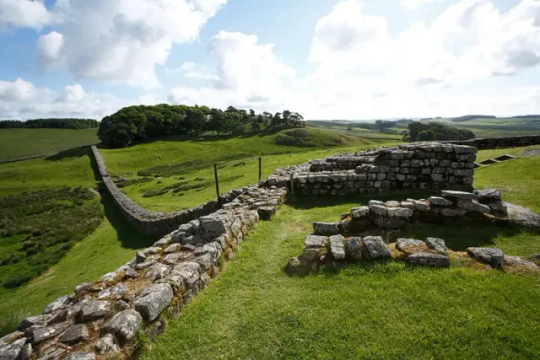
Hadrian, who ordered the wall to be built in 122CE after a visit to Britannia, had a different vision of empire than his predecessors, says Frances McIntosh, curator for English Heritage’s 34 sites along Hadrian’s Wall.
“All the emperors before him were about expanding the empire, but Hadrian was known as the consolidator,” she says. He relinquished some of the territory acquired by his predecessor Trajan, and “decided to set the borders” – literally, in some cases, with wooden poles at sites in Germany, or with stone in Britannia. Where those poles rotted thousands of years ago, the wall is still standing: “A great visual reminder” of the Roman empire, says McIntosh.
It’s not just a wall. There’s a castle every mile along, and turrets at every third-of-a-mile point, with ditches and banks both north and south. “You can imagine the kind of impact that would have had, not just on the landscape but on the people living in the area,” says McIntosh.
And thanks to the finds from the wall, we know a surprising amount about those people.
Although historians have long thought of army outposts as remote, male-dominant places, the excavations along the wall show that’s not the case. Not only were soldiers accompanied by their families, but civilians would settle around the settlements to do business. “ You can almost see Housesteads as a garrison town,” says McIntosh. “There were places you could go for a drink and so on.”
The Roman rule of thumb was not to post soldiers in the place they came from, because of the risk of rebellion. That meant Hadrian’s Wall was a cultural melting point, with cohorts from modern-day Netherlands, Spain, Romania, Algeria, Iraq, Syria – and more. “It was possibly more multicultural because it was a focus point,” says McIntosh, who says that the surrounding community might have included traders from across the empire.
Soldiers were split into two groups. Legionaries were Roman citizens from Italy, who had more rights than other soldiers and imported olive oil, wine and garum (a sauce made from decomposing fish).
They worked alongside auxiliaries – soldiers from conquered provinces, who had fewer rights, but could usually acquire citizenship after 25 years of service.
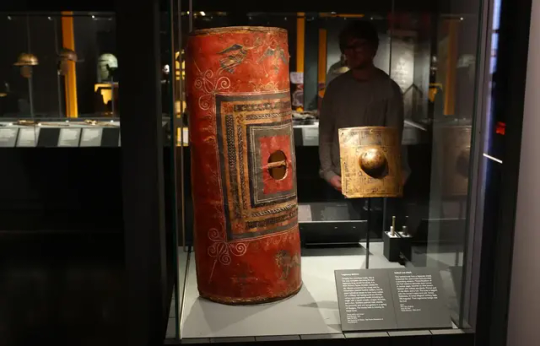
Soldiers carved their names and regiments on stones to show which part of the wall they built – around 50 of them are on display at Chesters fort.
But the wall shows that women and children were equally present.
McIntosh says that pottery brought to the camps – from the Low Countries and North Africa – shows that the soldiers “brought their families, who cooked in traditional style.” Archaeologists have found what seems to be an ancient tagine for North African-style cooking.
A tombstone from Arbeia fort for a woman named Regina shows she was a freed slave from southern Britain who was bought by – and married to – a Syrian soldier.
Another woman buried at Birdoswald fort was laid to rest with chainmail that appears to be from modern-day Poland. “Perhaps she married someone in the army,” says McIntosh, who calls the wall a “melting pot of people from all over the world under the banner of the army.”
“They brought their own religions, as well as worshipping Roman gods and adopting local deities,” she adds. At Carrawburgh, a temple to Mithras – an originally Persian deity – sat near a spring with a shrine to a local water spirit.
‘Wretched little Brits’

Some of the most extraordinary finds from the Roman empire are coming from one site on Hadrian’s Wall: Vindolanda. Here, archaeologists have found a wealth of organic remains because of what curator Barbara Birley calls the “unusual conditions onsite.”
At Vindolanda there are the remains of at least nine forts over 14 levels. “When the Romans would leave, they would knock down timber forts, and cover the area with turf and clay, sealing the layers underneath,” she says.
“Because it happened so many times, the bottom five or six layers are sealed in anaerobic conditions, so things don’t decay. When we get down there, we get wooden objects, textiles, anything organic.”
Vindolanda has the largest collection of Roman textiles from a single site in western Europe, as well as the largest leather collection of any site in the Roman empire – including 5,000 shoes, and even a broken leather flip-flop. “We probably had a population of 3,000 to 6,000 depending on the period, so 5,000 is a lot,” says Birley. For Abdy, the shoes evoke the conditions of the wet borderlands. “Women’s and children’s shoes are hobnailed – you needed it in the mucky frontier dirt tracks. They’re very evocative.”
There’s even a wig made from a local plant, hair moss, which is said to repel midges – the scourge of Scotland during the summer. A centurion’s helmet is also crested with hairmoss – the ancient equivalent of spraying yourself with insect repellent.
The first woman to write in Latin

One of the most famous finds is the trove of wooden writing tablets – the largest found anywhere.
“They give a snapshot of what life was actually like,” says Birley. “We understand so much more from written correspondence than from ‘stuff,’ and, archaeologically, it’s the stuff that usually survives – things like metals and ceramics.
“These were written in ink, not on a wax stylus tablet, and we believe they were used for what we’d put in emails: ‘The roads are awful,’ ‘The soldiers need more beer.’ Everyday business.”
The tablets – or “personal letters” as Birley describes them – were found on the site of a bonfire when the ninth cohort of Batavians (in the modern-day Netherlands) were told to move on.
“They had a huge bonfire and lots of letters were chucked in the fire. Some have been singed – we think it may have rained,” she says. One of them calls the locals “Britunculi” – “wretched little Brits.” Another talks about an outbreak of pinkeye. One claims that the roads are too bad to send wagons; another laments that the soldiers have run out of beer.

Among the 1,700 letters are 20 that mention a woman called Sulpicia Lepidina. She was the wife of the commander of the garrison, and seems to have played a crucial role. There’s a letter to her from another woman, Paterna, agreeing to send her two medicines, one a fever cure.
Birley says it’s similar to today. “If you’re a group of moms, still today we say, ‘Do you have the Calpol?’ It’s very human.” For Abdy, it’s a sign that women were traders. “She’s clearly flogging her medicines,” he says. “It’s really great stuff.”
Another tablet is an invite from Claudia Severa, the wife of another commander at a nearby camp. It’s an invitation to a birthday party. Under the formal invitation, presumably written by a scribe, is a scrawl in another hand: “I shall expect you, sister. Farewell, sister, my dearest soul.”
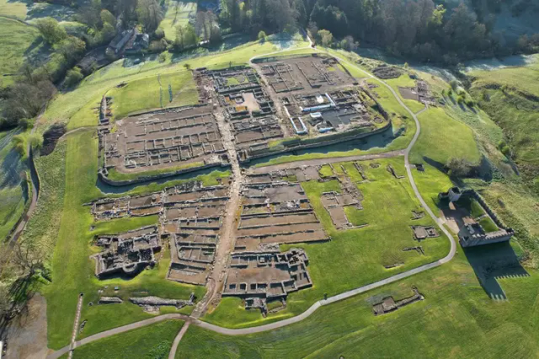
Presumably written by Claudia herself, it is thought to be the earliest example of a woman’s handwriting in Latin.
Without the organic finds – the shoes and the letters that indisputably belonged to women, unlike jewellery or weaving equipment – it’s difficult to prove conclusively that women lived in significant numbers. Vindolanda “illustrate the missing gaps,” says Abdy. For Birley, they prove that women were as crucial a part of army communities as men. “Before the Lepidina tablets were found we didn’t really understand the interactions between the soldiers and their wives,” she says. Another tablet is written by what is thought to be a Spanish standard-bearer’s common-law wife, ordering military equipment for her partner.
“The Vindolanda collection is showing that there weren’t just camp followers and prostitutes; women were part of everyday life, and contributing to the military community in many ways,” says Birley.
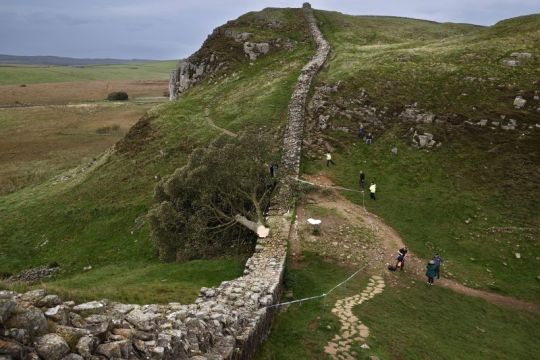

Abdy says that Hadrian’s Wall is interesting because the resident women span “all classes of society,” from Regina – the dead freedwoman, who would have been “bottom of the heap” – to the trader Paterna and the noblewoman Lepidina.
And of course, there’s the wall itself.
“In the Netherlands and Germany the finds are often stunning and better preserved – you go to museums and are bowled over. But in terms of structural remains, Hadrian’s Wall must be among the best,” says McIntosh, modestly, of her site.
Abdy agrees: “I can’t think of many symbols so redolent of imperial will than that wall.”
By Julia Buckley.
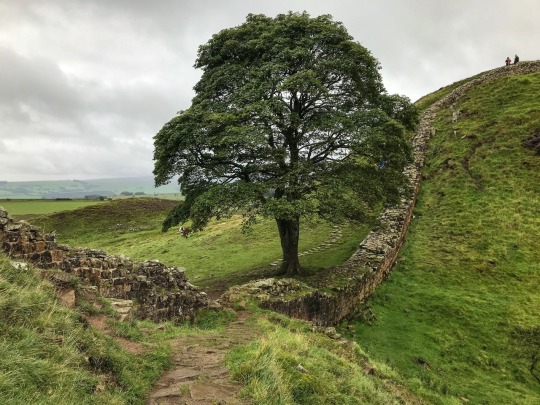
#How Hadrian’s Wall is Revealing a Hidden Side of Roman History#Hadrian’s Wall#emperor hadrian#northwestern boundary of the Roman Empire#Britannia#Caledonia#roman legions#ancient artifacts#archeology#archeolgst#history#history news#ancient history#ancient culture#ancient civilizations#roman history#roman empire#long post#long reads
911 notes
·
View notes